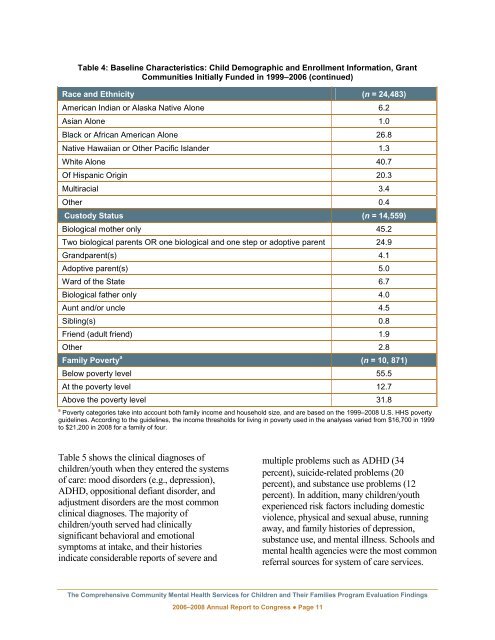Evaluation Findings - SAMHSA Store - Substance Abuse and Mental ...
Evaluation Findings - SAMHSA Store - Substance Abuse and Mental ...
Evaluation Findings - SAMHSA Store - Substance Abuse and Mental ...
You also want an ePaper? Increase the reach of your titles
YUMPU automatically turns print PDFs into web optimized ePapers that Google loves.
Table 4: Baseline Characteristics: Child Demographic <strong>and</strong> Enrollment Information, Grant<br />
Communities Initially Funded in 1999–2006 (continued)<br />
Race <strong>and</strong> Ethnicity (n = 24,483)<br />
American Indian or Alaska Native Alone 6.2<br />
Asian Alone 1.0<br />
Black or African American Alone 26.8<br />
Native Hawaiian or Other Pacific Isl<strong>and</strong>er 1.3<br />
White Alone 40.7<br />
Of Hispanic Origin 20.3<br />
Multiracial 3.4<br />
Other 0.4<br />
Custody Status (n = 14,559)<br />
Biological mother only 45.2<br />
Two biological parents OR one biological <strong>and</strong> one step or adoptive parent 24.9<br />
Gr<strong>and</strong>parent(s) 4.1<br />
Adoptive parent(s) 5.0<br />
Ward of the State 6.7<br />
Biological father only 4.0<br />
Aunt <strong>and</strong>/or uncle 4.5<br />
Sibling(s) 0.8<br />
Friend (adult friend) 1.9<br />
Other 2.8<br />
Family Poverty a (n = 10, 871)<br />
Below poverty level 55.5<br />
At the poverty level 12.7<br />
Above the poverty level 31.8<br />
a Poverty categories take into account both family income <strong>and</strong> household size, <strong>and</strong> are based on the 1999–2008 U.S. HHS poverty<br />
guidelines. According to the guidelines, the income thresholds for living in poverty used in the analyses varied from $16,700 in 1999<br />
to $21,200 in 2008 for a family of four.<br />
Table 5 shows the clinical diagnoses of<br />
children/youth when they entered the systems<br />
of care: mood disorders (e.g., depression),<br />
ADHD, oppositional defiant disorder, <strong>and</strong><br />
adjustment disorders are the most common<br />
clinical diagnoses. The majority of<br />
children/youth served had clinically<br />
significant behavioral <strong>and</strong> emotional<br />
symptoms at intake, <strong>and</strong> their histories<br />
indicate considerable reports of severe <strong>and</strong><br />
multiple problems such as ADHD (34<br />
percent), suicide-related problems (20<br />
percent), <strong>and</strong> substance use problems (12<br />
percent). In addition, many children/youth<br />
experienced risk factors including domestic<br />
violence, physical <strong>and</strong> sexual abuse, running<br />
away, <strong>and</strong> family histories of depression,<br />
substance use, <strong>and</strong> mental illness. Schools <strong>and</strong><br />
mental health agencies were the most common<br />
referral sources for system of care services.<br />
The Comprehensive Community <strong>Mental</strong> Health Services for Children <strong>and</strong> Their Families Program <strong>Evaluation</strong> <strong>Findings</strong><br />
2006–2008 Annual Report to Congress ● Page 11

















